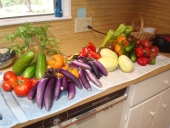posted 5 years ago
OK. So I made a mistake. I have a very long list of plants I want to grow this year, and managing inside start times and planting out times became super complicated, so I after trying to make a master list of the details I needed, I just went for it and started, with a very loose plan. Then the pandemic hit and I went plant start crazy! Now I wish I had a more strategic plan.
Our average last frost is May 10.
I have several plants now, such as basil, marigolds, etc. Too many starts to count. I have some like chard, dill, cilantro and parsley, that can probably go out, but are very small. And the best thing is that I have warm and cool season plants coexisting in my 1020 seed flats.
Some of them seem to need to move up, but I'm out of space and containers. Of course, the plants that are ready to be transplanted are the warm season ones, not the cool season ones :(
My question is, how to keep the plants happy through this tight squeeze. I feel the need to fertilize, but need your opinions. I should also possibly move up in pot size (which is challenging due to lack of room and I am out of seed flats again).
Thoughts?
Also, I am willing to give away my surplus plant starts or even trade for something small. I'm just outside of Asheville, North Carolina and would love to share.

 3
3




 2
2




 1
1




 3
3




 4
4




 1
1




 2
2




 2
2









